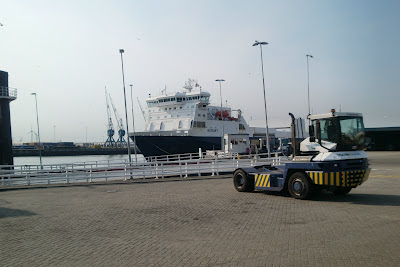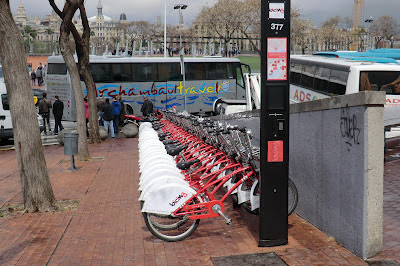 |
| In Europe the main hub of short sea shipping (SSS) is Rotterdam |
For years, the European Union has been trying to potentiate intermodal transport. The policies which emerged in the year 2001 were orientated in passing part of the goods transport from the road to the rail. However, time showed that it made no sense to force reality, as a mistrust and competition between these two modes of transport was generated which prevented the creation of the necessary synergies for a sound development of intermodal transport. Comodality has been an intent to advance with the idea of a transport system that makes use of all the available transport modes in an economic and environmentally beneficial way. The focus of these policies is no longer in which mode has to be potentiated, but in the analysis of the itineraries and in efficient and effective modes which allow for a profitable and sustainable transport no matter which mode has been chosen.
Over the last 10 years we have had a number of European directives which have tried to potentiate intermodal transport though at the moment not very successfully. The directives 96/48CE and 2001/16/CE indented to activate the inter-usability of the transeuropean high speed rail system and the conventional rail. In these directives the conditions for a secure and continued train circulation were laid down; with a competitive performance and without big technical or operative reglementary differences between the European countries. The attempts we have had in Europe to make the international markets of the rail transport more transparents have not received sufficient support from all the states of the European Union. Recently the European Commission has disciplinarily prosecuted various states for this reason. The first package designed by the European Union consisted of 3 directives which obliged to open competition in the goods rail market. The time for implemention expired in 2003. This package of measures obliged the member states to guarantee the right of access to the international services of the transeuropean net of terrestrial transport (TEN-T). Already in the year 1996 the European Community took the decision 1692/96/CE due to which the transeuropean transport network was created and 30 projects were declared of “European interest”.
The investment projects TEN-T proposed by the European Commission which affected Spain were the following:
Project 3: Axes for high velocity railway in the southwest of Europe
Project 8: Moltimodal axes Portugal / Spain – rest of Europe
Project 15: GALILEO network. Tecnology for navigation via satellites for the positioning and synchronisation of various services in Europe.
Project 16: Goods railway axis Sines/Algeciras - Madrid – Paris. (Over the Central Pyrenean Crossing)
Project 19: Inter-usability of railways of high velocity in the Iberian Peninsula. The main objective was to overcome the problem of the specific width of the Iberian rails to the construction of new rails with the European width.
Project 21: Short Sea Shipping (marine highway). West Europe, south-east Europe and Mediterranean.
If we revise these projects, we will see that most of them have been accomplished only partially, some of them even have a considerable delay, but nonetheless they are fundamental in the structuring of the intermodal network of the Iberic Peninsula.
The new European decree 913/2010, of 22.09.2010, defines the European railway corridors and its administrative organs. In this decree I would highlight the definition that is made of the supervisory boards of the European corridors, which superpose themselves over the stately administrators of the railway infrastructures, in order to achieve the necessary coordination in the inter-usability, a step forward in the potentiating of the European railway transport and intermodality. Of all the routes mentioned in the attachment of the decree, route no. 4 (via the Atlantic Ocean) and route no. 6 (via the Mediterranean) have to be pointed out, which have the 10.11.2013 as deadline for their beginning of operation. Both affect the peninsular territory and are in consonance with the projects of the European Transportation Network.
Since 2004 the multi-sector association FERRMED, an initiative of the private sector, has been working with the objective to improve the goods transport in Europe. This associations has a variety of proposals, for example the introduction of standards in the railway network with regard to: Voltage, width of rails, the loading gage of tunnels and bridges, the ERTMS (European Rail Traffic Management System) for indication and traffic administration, etc. Furthermore, they propose the design of new concepts for locomotives and wagons and even make recommendations for technological improvements for the automatic connection of the wagons. All these are aspects that open up new possibilities for new automated solutions in the administration of intermodal terminals. This lobby has achieved the support of the European Union and of various member states. The big commitment of FERRMED is the creation of a railways axis which will reach from Scandinavia, over the areas of central Europe of Rhine and Rhone, to the limits of the Western Mediterranean. In the area of Spain it is one of the principal defenders of the Mediterranean corridor.
The European Union is updating anterior investment projects TEN-T, in which a big part of the claims the FERRMED association has raised are included. Let us hope that the European Commission will implement those projects supported by the member states that are best adapted to those parameters of economic efficiency and environmental benefit, which justify such an important investment in times of crisis. In Spain, as always, the big problem will be to fight with the inter-territorial tensions to reach Brüssel with an agreed on statement.





